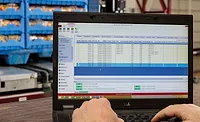Fleet managers turn to route optimization to cut delivery costs
Route optimization, tracking software boost distribution efficiency
Even though fuel costs have stabilized somewhat, few other items are immune from upward price trends, and competition shows no signs of letting up. With this in mind, it’s as important as ever for fleet managers to wring every penny possible out of delivery costs.
Some long-term decisions, such as equipment acquisition, can have a lasting effect on the bottom line, but these areas tend to deliver only incremental results. The biggest opportunity for a fleet manager to contribute to the bottom line is at the near-term decision level by optimizing delivery operations with the most efficient delivery routes and utilizing load configurations that will eliminate miles altogether.
When trying to keep delivery operations efficient, it’s rare for fleet operators to find any low-hanging fruit. But when the search for efficiency is expanded, there are plenty of less-than-obvious ways to cut delivery costs while at the same time maintaining or improving customer service.
In Beverage Industry’s Fleet Survey, roughly two-thirds of the respondents cited route optimization as their top strategy for controlling fuel costs; however, purpose-built route/load optimization software packages have yet to find very wide acceptance in the beverage industry.
Although it might be practical for the (very) smallest of fleets to manually optimize their routes, use a homemade spreadsheet, or work with a delivery function attached to an inventory or billing program, purpose-built route/load optimization software packages can be cost-effective solutions for fleets with as few as 10 trucks.
Even an already efficiently run, average-sized fleet can find significant opportunities to improve productivity that might not have been apparent without this specialized software. At Crescent Crown Distributing, Mesa, Ariz., organizing routes with common delivery parameters to maximize the productivity of each truck has helped the company reduce overall fleet mileage during a time when its customer base dramatically expanded.
According to Executive Vice President of Operations Rich Marchant, Crescent Crown was able to reduce overall miles by 16 percent in the last five years, during a time when the company’s volume was growing by roughly 2 percent annually. That reduction in fleet miles and utilizing varying types of equipment enabled the company to reduce its overall fleet by 15 vehicles. Key components of their efficient delivery operation include the use of Roadnet routing/loading software to build delivery routes and optimize truck loading configurations, along with Greenmile GPS and GeoTab software to track the fleet.
One less-than-obvious routing/loading strategy employed by Crescent Crown is allowing a certain amount of geographic overlap in the early stops on some routes to ensure that every truck is loaded closer to capacity.
Route optimization also can improve customer service. In addition to determining the most efficient routes based on available fleet resources and the day’s delivery orders, optimized routes enable a distributor’s customers to better schedule their labor resources based on more accurate delivery windows.
But the need for gathering and maintaining detailed delivery records also is critical. If a dispatcher leaves the company or takes a vacation, delivery records should be sufficient to allow any manager to step into the dispatcher’s role with minimal disruption to operations. Even the most powerful routing software solutions are only as successful as the available customer and delivery data.
At Crescent Crown, keeping a highly accurate and frequently updated database of delivery location parameters is a key to the routing strategy. Data collection doesn’t stop once the initial customer file is created. Frequently updated information is especially important when a new or substitute driver is assigned to a route.
Fred Biagi of VinLux Fine Wine Transport, Napa, Calif., affirms the importance of capturing driver knowledge to better refine the routing process but notes that sometimes even the best routing plan can run into real-world conflicts.
“Drivers end up altering routes about 25 percent of the time due to long-term construction, traffic patterns or customer needs,” Biagi says.
In addition to enabling easier transitions between dispatchers, the software also cuts the time needed to complete the routing process each day. “Effective use of the software system has enabled the VinLux dispatchers and warehouse managers to minimize paperwork and spend more time responding to customer needs,” Biagi says.
Optimizing delivery operations also requires a look at loading configurations. Separating products by bay in a side-loader is becoming less and less practical, so many distributors are moving to bulk bodies and trailers. The bulk bodies and trailers offer flexibility that brings the potential for more dynamic routing and maximizing the utilization of each truck.
Just as with routing, load optimization requires the collection and maintenance of accurate, up-to-date records of product and equipment data such as product pack size and weight, stacking limits, and truck weight and volume capacities. Additional customer location data, including truck size limits and the site’s compatibility with liftgates, cart deliveries or palletized loads, also is needed.
Looking for a reprint of this article?
From high-res PDFs to custom plaques, order your copy today!






